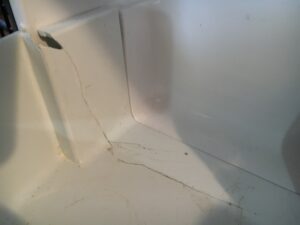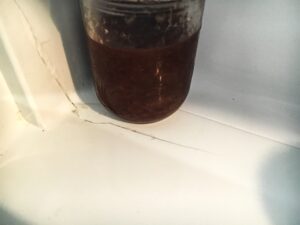Preparation
Make sure that, like using any other types of glue products, the surfaces that you are going to glue together are cleaned properly. Also, you can paint over Mister Glue and other types of cyanoacrylates but usually they will not stain. So, you need to protect other surfaces. This glue is pretty runny, so it can drip onto other surfaces if you are not careful.
So, clean and protect wood surfaces.
Application
I’ve included three videos on this page. You can see in the video where I stand on the two boards after glueing them together with Mister Glue, that I’ve only let it set for a minute or so. I’m actually pressing the boards together with my feet for only 23 seconds. The set time is generally 20-30 seconds. Full cure time is several hours. I’ve glued boards together like that where I didn’t think it worked so set aside and gone back a few hours or a day later and could not get the two pieces apart to save my life.
So, standing on the two planks right after gluing together looks like fun and all but it is one of those “Don’t try this at home!” types of thing.
In the case of the two boards, I had to mist them with water and let that moisture soak in before applying the Accelerator to one side and Mister Glue to the other.
Also, please note, that when I applied the glue to the board that I was standing on, that I did not spread the glue after running a bead on the wood. Spreading it first after applying the glue and before putting the two surfaces together in technical terms is a ‘no-no’! Don’t do it. It will weaken the glue. Just put enough on the wood so that it will spread. You do want the surface mostly covered but the thinner the bond the stronger.
With Mister Glue’s Accelerator it is not really spreadable on wood. Brush it on with the small applicator and it soaks in. If you were to use on a slick surface, you could spread to cover the surface. Apply the Accelerator to one side and apply it first. You want to allow 20-30 seconds exposed to air before you press the glue sided surface to it. And with Mister Glue you don’t want to wait.
Note: A point here on adding a bit of moisture. Some will caution and warn against having too much water/moisture around cyanoacrylates (Mister Glue, Super Glue) but remember they need some moisture to operate. BUT very small amounts. I sprayed the board with a mist then wiped with a paper towel. It would not have hurt to leave a bit if the surface is too moist.
Mister Glue should be treated in many ways the same as any other cyanoacrylate. Superglue, Crazy Glue you can find in stores. Other products like Pasco Fix and Mister Glue you will generally find at various types of trade shows or online. The latter will not dry out in the bottle and will last for years as long as they are kept in the freezer (ideally) or the refrigerator. The later are generally stronger and won’t break down over time as they have had the solvents removed. Mister Glue and products like it and Pasco Fix are made in Germany and are distilled several times to remove any solvents. This is why they won’t dry in the bottle and why the bond won’t go brittle after a time.
Cyanoacrylates react to very small amounts of moisture in or on the surface of the materials that you are attempting to bond together. Super glue types of glue are also extremely fast to bond.
Mister Glue Wicks In Wood Joints
One of the biggest problems with Mister Glue and other cyanoacrylates is because of the speed of bonding, there is often very little time to reposition the two surfaces. In this second video below you can see how I’ve gotten around this. I’ve placed the two pieces of wood together in a table vise and applied the glue to the edge and let it wick in. Which it does extremely well as you can see from the resulting bond. In this video, I probably should have, but didn’t, put a bit of moisture on the surfaces beforehand.
Mister Glue on its own will not fill gaps. It is too thin, too runny. But it works in combination with all types of materials as a filler. In the video below you can see how I’ve built up a loose screw hole with layers of sawdust and Mister Glue. With no discernible wait time, I put a screw in the glue/sawdust filled hole and right afterwards tried to wrench it out. No go. It was solid. One could take a bit more time with this and tamp down each bit of sawdust before adding glue. In this particular case not a huge amount of glue was used.
If you have some really fine sawdust, use it for repairing a loose spindle in a chair. Or a chair leg. I’ve used both sawdust and baking soda for this. The spindle or leg is wobbly. Feed some fine sawdust or baking soda into the gap. Just keep shaking it in there, working it in until the gap is completely filled. Then add a few drops of Mister Glue all the way around. It will wick in very nicely. Within seconds you have a solid, no longer wobbly chair or table. The wood fill done this way will not shrink or crack over time.
You are not likely going to do use this glue to fill large areas. But it is great for harder to reach areas and small cracks and splits. You can use to build up a small area that has been chipped or gouged. You can tool and sand afterwards. If you are going to use this way, for gouge or some such, shape the wood filler as much as possible beforehand. It goes hard almost instantly so there is no use trying to shape it with your fingers as you would some putty types glues. And your fingers would likely be rather solidly glued to the item you are trying to repair, anyway.
As mentioned earlier, although it can be painted, the wood fill made this way with Mister Glue will not usually take a stain.
Use a Finishing Glue
There is a very decent article on Canadian Woodworking Magazine on using this type of glue for finishing surfaces as it does dry clear. Mister Glue has a ‘thin’ viscosity so works well for this.
General Info On Mister Glue
Mister Glue is water resistant so if you are bonding wood that will be exposed to the weather it works well.
A couple of extra points. I have read on some websites that one should not put cyanoacrylates back in the freezer or refrigerator after opening. As long as you burp the bottle a tap it down so there is no glue left in the spout, all should be good. Occasionally, the spout clogs with some dried glue. Peel it off with your fingers. Take care not to glue your fingers together. You will get a little on your fingers when you do this but that will come off fairly quickly and will do you no harm in the meantime. If you have been careless and the cap removes the spout when you take it off, use a pair of needle nose pliers to take the spout out of the cap. Then get a narrow screwdriver or knife in there to scrape out any dried glue. If the cap seems to be glued on use a pair of pliers squeezing to gently crack the glue inside. This should enable you to get the cap off. Again, clean off any dried glue and be more careful next time.
There is more on care of Mister Glue here.
And you can purchase at our Shop page.


 For plastics, we used baking soda. This was a shelf in a refrigerator that was broken when we moved into our new house. Being difficult to replace and rather expensive when I did find it, I decided to try to repair with Mister Glue. I also was very interested in how this would work.
For plastics, we used baking soda. This was a shelf in a refrigerator that was broken when we moved into our new house. Being difficult to replace and rather expensive when I did find it, I decided to try to repair with Mister Glue. I also was very interested in how this would work. could show y’all how the fillers work with the glue!
could show y’all how the fillers work with the glue!